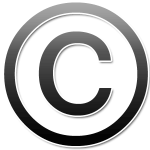Trending posts on SitePoint today:
- Is Using SVG Images Good for Your Website’s Performance?
- Five Techniques to Lazy Load Images for Website Performance
- Five CSS Performance Tools to Speed up Your Website
- How to Choose, Register and Make the Most of Your Domain Name
- Deploy & Manage Multiple WordPress Sites with ServerPilot

The vast majority of websites have a copyright notice in the footer. Most designers do this as routine on all websites they design. But what exactly does it mean and what protection does it provide? This is vital information for web professionals to know. Here are answers to some common questions related to copyrights.
Please note: This information is based on copyright laws in the U.S. as provided on www.copyright.gov. It is provided as general information and is not a substitute for professional legal advice.What Is a Copyright?
According to the U.S. Copyright Office, “Copyright is a form of protection provided to the authors of ‘original works of authorship,’ including literary, dramatic, musical, artistic, and certain other intellectual works.” The basis of the U.S. law is the Copyright Act of 1976, which gives authors of original works exclusive rights to the works and the option to grant usage rights to others. Generally, the rights include:- Reproduction
- Development of derivative works
- Distribution
- Public display
How Can I Copyright a Website?
Original work is copyrighted from the moment of creation, provided it’s fixed in tangible form. What does “fixed in tangible form” mean? This means that the work has to be documented or communicated in an observable way, either directly or through a machine or device. Some examples of fixed in tangible form include written on paper, saved on a hard drive, or captured on a recording device. Ideas, systems and methods cannot be copyrighted. A website — graphics, content, visual elements — is copyrighted at the time of development. So putting the copyright notice on the bottom of a site states that the material displayed is not to be used without permission of the owner. In fact, you don’t even need the notice to claim copyright; the law eliminated the requirement of public notice in 1989. To take this one step further, copyright registration is an option when protecting online works. Registering a copyright provides a public record of ownership, plus registration is necessary before filing an infringement suit in court, should you ever need to do so. You can register online or by mail, by providing an application, a non-refundable fee (which is currently $35 for online registration), and a non-returnable deposit. The deposit is the entire work to be copyrighted (i.e. the website), which can be uploaded or sent in via CD. This is important to note: the registered copyright only extends to the works included in the deposit. If you update the website after filing the copyright, you will need to register again for the new material. There are two cases (databases and serials/newsletters) where, if you meet the requirements, you can register in three-month chunks, with the copyright covering three months at a time. See Circular 62b for more information serials and newsletters, and Circular 65 for more information on databases. Please note: At the time of writing this, Circular 65 was being revised and was unavailable.Who Owns Copyrighted Material?
Generally, the creator owns the rights to the work, except in the case of a “work for hire” arrangement, such as an employer/employee relationship. If you’re a freelancer or business owner hired to create a specific work, you are considered the creator and retain all rights, unless you have a “work for hire” agreement with the client that grants them ownership of the work. These details should be negotiated and outlined in your contract for every job so there is no question about ownership. This paragraph has been corrected from the initial post which misstated the designer’s rights.Does a Copyright Extend Internationally?
There is not a world-wide copyright, but many countries adhere to international copyright treaties and conventions for foreign works. Review Circular 38a for a list of countries and their copyright laws. For more information on copyrights, how to register and current fees, visit www.copyright.gov. If you enjoyed reading this post, you’ll love Learnable; the place to learn fresh skills and techniques from the masters. Members get instant access to all of SitePoints’ ebooks and interactive online courses, like Build a Successful Web Design Business. Comments on this article are closed. Have a question about copyright? Why not ask it on our forums?Frequently Asked Questions (FAQs) about Website Copyright
What is the significance of a copyright notice on a website?
A copyright notice on a website is a statement placed on the site to inform users that the content is protected by copyright law. It serves as a warning to potential infringers that the owner of the website has exclusive rights to the content. Although it’s not mandatory to have a copyright notice, it can deter unauthorized use of your content and can be beneficial in a legal dispute over copyright infringement.
How can I copyright my website content?
Copyright protection is automatic once your original work is created and fixed in a tangible form. However, registering your copyright with the U.S. Copyright Office provides a public record of your copyright claim and can strengthen your case in a copyright infringement lawsuit. You can apply for copyright registration online through the U.S. Copyright Office’s website.
What should a website copyright notice include?
A standard website copyright notice should include the copyright symbol (©), the year of first publication, the name of the copyright owner, and a statement of rights. For example: © 2022 John Doe. All rights reserved.
Where should I place the copyright notice on my website?
The copyright notice is typically placed in the footer of the website, where it can be easily seen but does not interfere with the main content of the site. However, it can be placed anywhere on the site as long as it is visible and clear.
Can I use copyrighted material on my website with permission?
Yes, you can use copyrighted material on your website if you have obtained permission from the copyright owner. This permission should be in writing and should clearly state the terms of use.
What happens if someone infringes my website copyright?
If someone infringes your website copyright, you can take legal action against them. This may involve sending a cease and desist letter, filing a DMCA takedown notice, or filing a lawsuit for copyright infringement.
How can I prevent copyright infringement on my website?
You can prevent copyright infringement on your website by clearly stating your copyright notice, monitoring your content regularly, and taking swift action if you discover any unauthorized use of your content.
Can I copyright the layout and design of my website?
Yes, the layout and design of your website can be protected by copyright as long as they are original and creative. However, functional elements such as menus and buttons may not be protected by copyright.
Do I need to update my copyright notice every year?
It’s a good practice to update your copyright notice every year to include the current year. This shows that your site is up-to-date and that you actively maintain your copyright.
Can I use someone else’s copyright notice on my website?
No, you should not use someone else’s copyright notice on your website. Your copyright notice should reflect your own copyright ownership and rights. Using someone else’s copyright notice could lead to legal issues.
Alyssa Gregory is a digital and content marketer, small business consultant, and the founder of the Small Business Bonfire — a social, educational and collaborative community for entrepreneurs.

